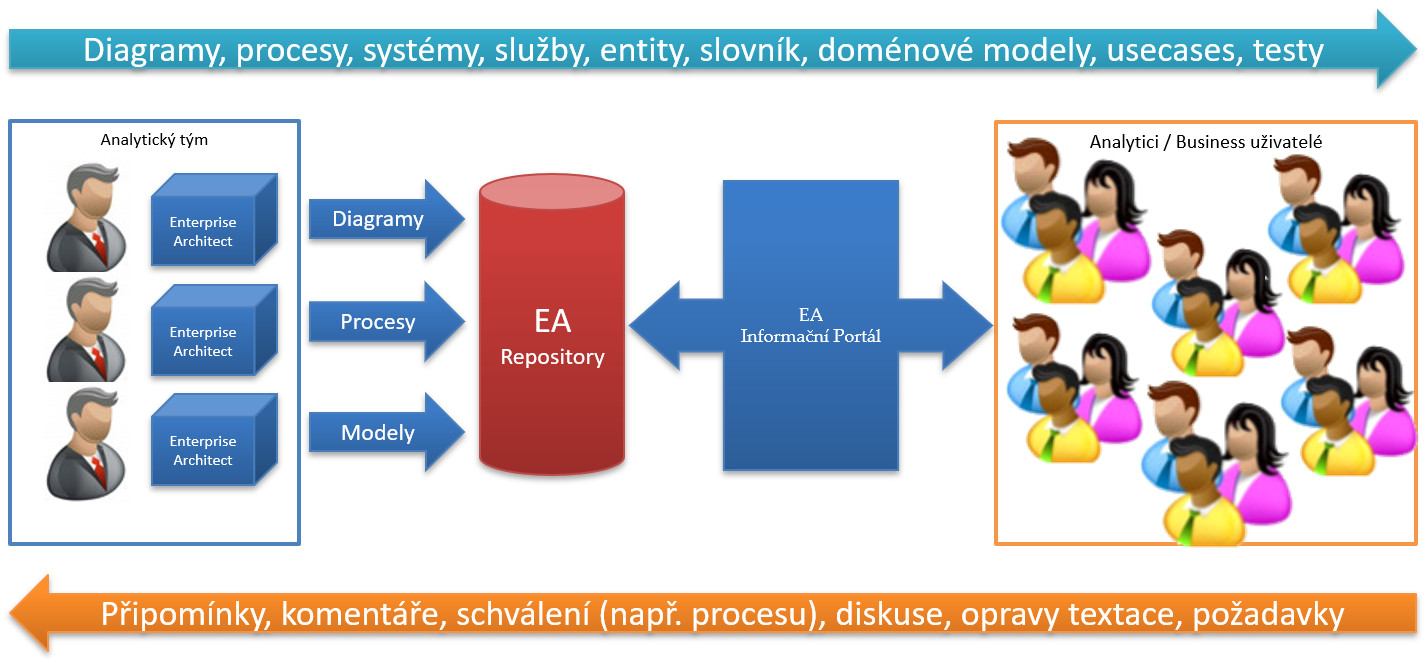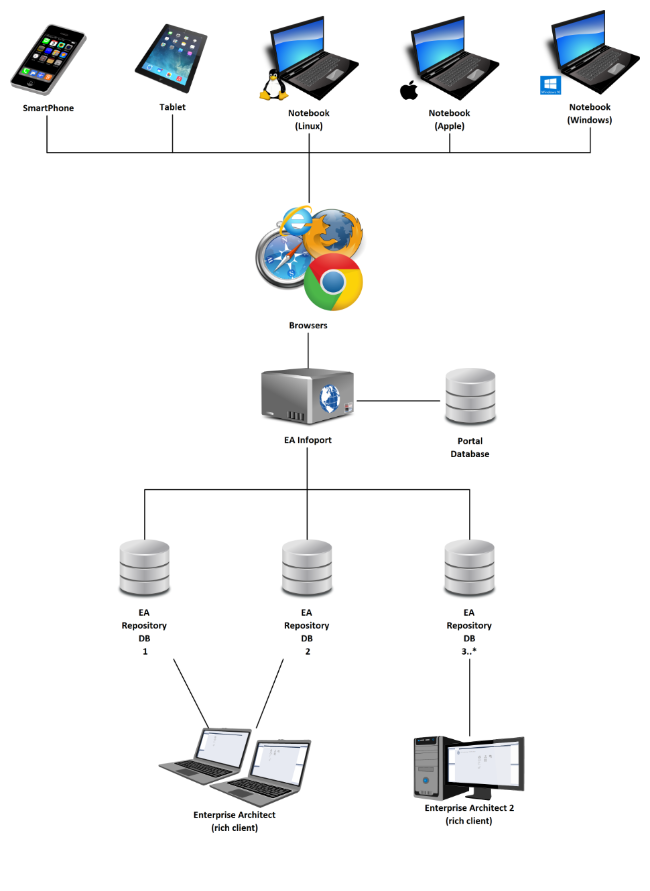EA Infoport complements the functionality of Enterprise Architect with a lightweight client displaying current data from the Enterprise Architect repository via a web browser (Chrome, Edge, Firefox). No exports or generating html are needed. The displayed data are still current. It brings greater security of information sharing – you can set, among other things, reading rights.
You will use EA Infoport successfully, for example if:
- You need to show diagrams and other information to people who do not have Enterprise Architect.
- You use Confluence, Wiki, SharePoint or similar CMS and need to display diagrams or other information embedded directly in their pages.
- You are a software company, and you want to show the upcoming models to your customers (and get feedback through discussions).
- You have multiple vendors, and you want to show them parts of a model so that everyone can see only what they need to see.
- You draw process books in BPMN and want to publish them for your employees.
- You are working on your non-commercial hobby project and want to publish its documentation as well.
- You want to work on a tablet or mobile phone, and you don't want to always export static html.
- You want to use advanced features such as permission to read part of a model, search and more.
Note: There is also a free edition for personal purposes, schools and non-profit organisations, as well as a corporate edition (with purchase under a service contract) and an edition for state organisations.

Architecture of the Enterprise Architect Information Portal
The EA Infoport application is a stand-alone component. It is built on Microsoft technologies (.NET and .NET Core) and uses Kestrel as an application server, which is actually a “lightweight” IIS and is also managed and developed by Microsoft.
It needs its own database for its operation (supported databases can be viewed in this list) and, of course, it must also have access to Enterprise Architect repositories (at least for reading, for writing in case users will use editing functions).
EA Infoport also needs disk space (several GB) for cache of graphical outputs (typically diagrams).
EA Infoport can also be connected to LDAP / Active Directory, if automatic login is required, using Windows Authentication and User Synchronisation for AD groups.
Minimum SW and HW requirements can be found here.
The following simple diagram summarises the principle of operation of the EA Infoport application.

History of the Enterprise Architect Information Portal Application Development
The Enterprise Architect Information Portal application has been developed since 2013 and has undergone several major changes, especially with regard to the technology platform.
The first versions were built on the PHP platform and from the beginning, the main emphasis has been on generating diagrams, all details of elements/diagrams, etc. and on ease of use.
PHP Platform
Version 1.x (2013)
The first release version of the application – implementation of basic functionalities: Repository browser, detail of artefacts, administration, authorisation system.
Version 2.x (2013)
The second release was focused mainly on optimisation and compatibility with web browsers, support for multiple types of databases, and improvements to the authorisation system.
Version 3.x (2014)
In the next release, requirements management modules, personal space, architecture module, Active Directory support and many small UI improvements were implemented.
Version 4.x (2015)
Implementation of the second main view – publication module including approval workflow. Performance optimisation and improvement of element detail, including its user settings.
Version 5.x (2016)
End of PHP version development (however, some customers still use it – it suits them). Implementation of the latest functionalities up to 5.x (reporting), preparation of the transition to J2EE, integration into Confluence, Sharepoint.
JE22 platform – Tomcat
Version 6.x (2016/2017)
Implementation of J2EE version (Tomcat was used as AS), the first version 6.x was deployed at the customer in August 2016.
Reimplementation of functionalities from version 5.x (main functionalities implemented), new functionalities according to customer requirements, complete redesign of UI. Complete reimplementation of all functionalities from version 5.x took place in Q1/2018.
However, there were many problems: J2EE technology proved to be unstable (in combination with COM technology); bug fixes took a very long time, and debugging, including the creation of automated tests, was difficult.
.NET platform – Kestrel
Version 7.x (2018)
2018 – Repeated reimplementation of basic functionalities this time on the final .NET platform
At the request of specific customers and due to the problems of J2EE vs COM, etc., we decided to change the platform again, this time definitively – by switching to .NET. It resulted in increased stability and performance (compared to Java version 6.x). The first customers received 7.0 in October 2018. In terms of functionality, it contains everything that 6.x does, though, significantly improved and stable.
Version 7.2 (2019)
Implementation of multiple repositories (complete kernel upgrade), authorisation system, reimplementation of the publishing module and workflow over it and more.
Version 7.3 (2020)
Active development, especially of editing functions and more…
